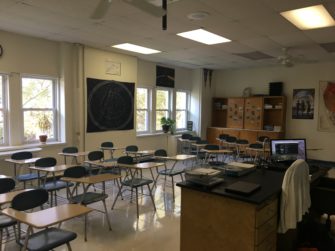
In September of 2019, I embarked upon my first year of teaching science at a small Catholic high school in the heart of North Philadelphia. Leading into the school year, I had assumed that the scientific and theological aspects of my undergraduate education would be most relevant to my new position, but as I navigated the ups and downs of being a first-year teacher (and eventually a first-year teacher amidst a global pandemic and a national reckoning with racial injustice), I soon came to realize that it was my background in peace studies that had most prepared me for what I would encounter in the classroom.
As the year progressed and I built relationships with my students, I became acutely attuned to the ways that violence in their communities impacted them and their ability to learn. My background in peace studies guided me as I supported and learned from my students as they lived amidst classmates lost to gun violence, food insecurity, poverty, racism, and homelessness. This background, along with my studies in theology, also pushed me to wonder how Catholic schools can most effectively draw on their theological roots to maximize their potential as religious peacebuilding institutions. What specifically can Catholic and religious schools (and by extension, the teachers who work there) do to be active agents of peace and support students living in contexts dominated by violence? This question was made even more intriguing because the vast majority of students at my school were not Catholic, and many were not religious at all.
While beginning my teaching career, I was simultaneously enrolled in a master’s-level teacher education program. My coursework addressed topics such as inquiry-based instruction, appropriate ways to assess student progress, and how to accommodate students with learning differences. For the most part, however, it did not attempt to engage with the reality of violence that encapsulates many students’ lives, the possibility that schools and education are an essential part of building a more peaceful and just society, nor the inherent reality of religion’s interplay with these ideas in the context of a faith-based educational institution. I was left to ponder and engage with these ideas on my own in real time in the classroom. Being an educator that values, above all else, building affirming relationships with students, meeting them where they are, and walking together on a path of growth demands that I listen and engage with the lived experiences of the students in front of me.

The questions I had hoped to explore in graduate school were questions that seemed important and relevant given my experiences teaching in North Philadelphia, and are relevant today as I teach at a privileged Catholic high school in the Midwest that is increasingly more diverse both racially and socioeconomically. How can teachers and students co-create peace? How can religious schools draw on the theological richness of their tradition and charism to maximize their potential as religious peacebuilding institutions? In what ways have students’ experiences in religious schools shaped their conceptions of peace, violence, and their own ability to be peacebuilders, regardless of students’ faith traditions? These are the questions drive me as an educator-peacebuilder.
I firmly believe that education should play an essential role in an intersectional approach to justice-oriented peacebuilding. It should affirm human dignity, dismantle systems of oppression, and empower people to be the fullest versions of themselves. Schools and teachers should foster cultures of peace and accompany students whose lives are encapsulated by violence. Their classrooms should be places where peace and justice come alive in real time. Religious schools are poised to be particularly powerful peacebuilding institutions if they can weave a theology and pedagogy of peace accompanied by justice into a school’s culture and the relationships built there. They can become places of encounter by employing spiritual beliefs, practices, and dispositions that can build peace at all levels of society. Catholic schools in particular are called to respond to the Gospel’s explicit demand to be peacebuilders, to stand with those otherwise cast aside, and to build a society that emanates God’s goodness, love, and mercy to all people.
This being said, to truly build positive peace, religious schools need to acknowledge that in certain cases, religion has played a role in perpetrating violence. Catholic schools are not exempt from this legacy. There have been many instances of sexual abuse by clergy in Catholic educational settings. Furthermore, many boarding schools for indigenous children in North America were run by Catholics. These boarding schools tore children away from their families, were ripe with abuse, and inflicted cultural violence by forcing children to abandon their indigenous heritage.
Beyond simply recognizing these and other histories of violence, Catholic schools should actively seek to combat violence perpetrated by religious institutions, schools included, and cycles of violence that religion might have begun. This requires that schools be cognizant of causes of direct, structural, and cultural violence and self-reflective about how their own practices have contributed to these forms of violence. In order to effectively counter any potential violence inflicted by religious schools, it is necessary that educator-peacebuilders in these institutions root themselves in the context of the school community and the lived experiences of the students and their families.
Any peacebuilding happening in the context of religiously affiliated schools must be grounded in a bottom-up, rather than a top-down, approach. A top-down model would begin with the religious tradition itself, then take students’ experiences and attempt to fit them within the framework of the tradition, doing away with anything and anyone that does not fit. A bottom-up model, however, begins with the students’ and community’s experiences, struggles, what brings them joy, the things that inspire them, how violence and injustice have impacted them, and their values and aspirations. Then, mindful of and informed by these things, the school and its faculty and staff can then discern how to best integrate the religious tradition in such a way that affirms what a student has lived through, offers support and encouragement, and invites students to advocate for peace and justice in their communities.
This shift in power dynamic grounds religious peace education in students’ lived experiences and is necessary given that many religious schools in communities impacted by direct and structural violence serve students who might not identify with the school’s faith tradition or any faith tradition at all. The only way for schools to effectively utilize their religious identity to build peace in these communities is to make their peacebuilding efforts accessible to students outside of the school’s own tradition. This approach also builds a bridge between Catholic education and the modern world, creating avenues of interaction and opportunities for growth.
There are multiple ways religious peacebuilding can play out in the space of Catholic education. Teachers can ask students to relate stories of liberation and redemption found in Christian scripture to their own lives, stories, and experiences, and can also integrate scripture from other traditions into the classroom. Schools can cultivate a prayer life that is inclusive, honors students’ faith traditions, and is rooted in their culture. Faith can offer a perspective on human dignity grounded in the Christian belief that each person is made in the image and likeness of God. If this perspective imbues a school culture in a profound way, it will have a positive impact on policies and procedures as well as on how the school interacts with its surrounding community. Christian teachings on mercy and reconciliation can inform discipline policies and procedures, shifting them towards restorative justice and away from strictly punitive practices. These teachings can also motivate Catholic schools to acknowledge violence inflicted by religious educational institutions and actively play a role in healing and justice. Many religious orders that sponsor schools offer frameworks and charisms to ground conversation and action in the classroom and beyond, such as the Critical Concerns of the Sisters of Mercy or the “Grad at Grad” profile used by Jesuit schools.

Catholic schools must meet students where they are at and truly know them and love them as they are. Encounter and relationship are essential elements of both effective peacebuilding and effective pedagogy. Employing a peacebuilding lens on Catholic education shifts the primary focus of a Catholic school away from conversion or indoctrination towards a theological imperative of care, with the primary goal being active accompaniment and the creation of a more just world.
Having at separate times inhabited the spaces of teacher education programs, formal theological study, communities immersed in direct and structural violence, Catholic school classrooms, and the study of peace and justice, I cannot help but wonder what each of these spaces can learn from each other. How can peace studies inform the work that is happening in schools and classrooms? How can the religious dimensions of one’s school increase its ability to build peace accompanied by justice? How can education and pedagogical practices be leveraged to engage in peacebuilding work in faith-based institutions?
As I continue my career as a Catholic-educator-peacebuilder, it is my hope that others will join me in an endeavor to draw on the richness of faith traditions, in Catholic contexts and otherwise, to make classrooms and schools places where true peace flourishes, grows, and overflows into the world, and places where students who live amidst violence can find comfort and hope. This post does not seek to provide definitive answers to the questions it poses nor cover every scholarly examination of these topics that already exists. Rather, inspired by my students, their experiences, and the relationships we built, it merely calls upon the disciplines and practitioners of religion, education, and peacebuilding to come together and learn from each other. It is my hope that together, these disciplines can collaboratively create something more beautiful than any of them could accomplish on their own.

